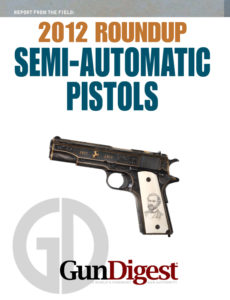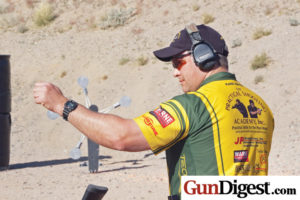 Read about semi-auto pistols perfect for 3-gun competitions in a free download from Gun Digest. Just enter your e-mail in the box below to get the PDF. You'll be signed up to receive free e-newsletters from Gun Digest and partners.
Read about semi-auto pistols perfect for 3-gun competitions in a free download from Gun Digest. Just enter your e-mail in the box below to get the PDF. You'll be signed up to receive free e-newsletters from Gun Digest and partners.[form id=”177771″]

Editor's Note: This article is an excerpt from the Complete Guide to 3-Gun Competition book, available now at GunDigestStore.com.
by Chad Adams
The sport of 3-gun competition falls within the discipline known as “action shooting,” which really is a politically correct term for practical shooting, the sport based on the quest for a higher level of combat shooting. While action shooting has been formally presented in America now for several decades, it has taken various shapes.
Today, action shooting has many forms, most of which traces itself back to the formation of the International Practical Shooting Confederation, or IPSC. Later, the United States Practical Shooting Association was formed as the U.S. domain of IPSC, as IPSC is truly international and branches into many countries around the world. The USPSA remains the strongest region, boasting more than 20,000 members nationwide.

The International Defensive Pistol Association (IDPA) is an offshoot of IPSC-style shooting, formed by shooters unsatisfied with the “gamesmanship” perceived to be prevalent within USPSA matches and rules. IDPA currently claims more than 19,000 members, and its competitions differ from IPSC’s primarily in their rules structure, which establish competitions leaning more towards self-defense or tactical-style shooting, rather than a test of pure shooting skills, as some view the matches of IPSC.
Both USPSA/IPSC and IDPA have been extremely successful in the U.S., but primarily as organizations that promote and sanction pistol competition. Three-gun competition, while influenced by USPSA rules already in place, has developed outside the vacuum of any one governing body, although 3-Gun Nation is quickly becoming the entity that bridges many matches and clubs together.
An event, or match, is a collection of individual courses of fire, commonly called “stages.” During each stage of multiple targets, a competitor, under the direction of a range officer, negotiates that stage—and keep in mind this is an action sport, so there’s lots of moving around from place to place, from one bank of targets to another, and so on—engaging each target as described during the stage briefing given by the range officer before the timer buzzer goes off.
That briefing varies in its instructions, ranging from strictly regimented courses that must be shot in a specific sequence, to free-form design, where the competitor is free to map their own strategy. A stage can have a specific starting area as limited as a small “starting box,” outlined by wood or metal staked into the ground. Stages can also have specific shooting areas, where certain targets must be engaged using particular firearms. Fault lines are also sometimes present, marking the end of the area of movement for a competitor—no shots may be fired outside of a shooting area or forward of a fault line without receiving penalty, which is applied to a shooter’s score in extra time.
After the stage briefing, the squad—a designated number of competitors that rotate through the match shooting each of the stages as a unit—is allowed a walk through period. Often limited to five minutes, competitors get a chance to see each target, walk the stage as they anticipate they’ll run it when it’s their time to shoot—this might include planning out where best to reload, how to approach and shoot over, under, or around a barricade, etc.—and ask any questions of the range officer.
It’s here that a 3-gun competition stage can get a bit complicated and even confusing. At a given match, there are numerous types of targets one might encounter. There are multiple sizes and types of paper targets, with the IPSC-style cardboard torso/head target the most common. (3-Gun Nation recently developed a new bull’s-eye-type paper target that will likely become more common in local club matches.)
